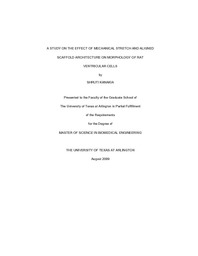| dc.contributor.author | Kanakia, Shruti | en_US |
| dc.date.accessioned | 2009-09-16T18:19:46Z | |
| dc.date.available | 2009-09-16T18:19:46Z | |
| dc.date.issued | 2009-09-16T18:19:46Z | |
| dc.date.submitted | January 2009 | en_US |
| dc.identifier.other | DISS-10373 | en_US |
| dc.identifier.uri | http://hdl.handle.net/10106/1782 | |
| dc.description.abstract | Heart disease is one of the major causes of death in developing and industrialized countries. Myocardial infarction leads to remodeling of the left ventricle, which severely affects the pumping efficiency of the heart. In order to provide mechanical support to left ventricle the scaffold material should be elastic and mechanically strong. For the success of cardiac graft in vivo one of the important factor is ability of cardiac myocyte morphology to resemble that in vivo. The goal of this study is to build thick, prevascularized cardiac graft for myocardial infarction repair. Mechanical stress has been recognized as one of the important factor for the development of haemodynamically active tissue like myocardium. We designed micro pattern created scaffold from elastic, biodegradable, biocompatible material Crosslinked urethane dopped polyester (CUPE). To provide mechanical stretch in vitro we designed a bioreactor system. The neonatal rat derived cardiomyocytes were cultured on CUPE films and they were subjected to mechanical stress in the bioreactor. The results were compared with cells cultured on polymer films having micropattern on them and films without micropattern. The results indicated that cells that were subjected to stretch exhibited aligned, rod shaped elongated morphology compared to the unstretched samples. Moreover, stretched cells increased in size significantly and demonstrated hypertrophy. The cells on films without without micropattern on it was randomly oriented, sparsely distributed and could not show noticeable increase in size. Whereas, the cells cultured on polymer films with micropattern were comparatively more aligned and elongated. From our findings we concluded that alignment and stretch plays an important role in morphology of the cardiac cells. Also survival and growth of cells on CUPE films suggests that CUPE is a promising material for cardiac tissue engineering. | en_US |
| dc.description.sponsorship | Kim, Young-Tae | en_US |
| dc.language.iso | EN | en_US |
| dc.publisher | Biomedical Engineering | en_US |
| dc.title | A Study On The Effect Of Mechanical Stretch And Aligned Scaffold Architecture On Morphology Of Rat Ventricular Cells | en_US |
| dc.type | M.S. | en_US |
| dc.contributor.committeeChair | Kim, Young-Tae | en_US |
| dc.degree.department | Biomedical Engineering | en_US |
| dc.degree.discipline | Biomedical Engineering | en_US |
| dc.degree.grantor | University of Texas at Arlington | en_US |
| dc.degree.level | masters | en_US |
| dc.degree.name | M.S. | en_US |
| dc.identifier.externalLink | http://www.uta.edu/ra/real/editprofile.php?onlyview=1&pid=1930 | |
| dc.identifier.externalLinkDescription | Link to Research Profiles | |

